
Chapter 8. Digitiser Synchronisation
Accurate time-stamping of samples is essential to seismology. Güralp Systems Ltd recommend the use of GPS receivers for generating clock signals wherever possible: they are the most accurate time sources available for all practical purposes. Where GPS receivers cannot be used but an internet connection is available, Network Time Protocol (NTP) can produce acceptable results. Platinum firmware can produce NTP-synchronised NMEA output for use with GPS-capable devices.
CMG-EAMs, CMG-DCMs and CMG-NAMs have an internal clock which is used to time-stamp log-file entries (but not data samples). This lock is managed by the NTP subsystem. CMG-DAS units and Authenticated Digitisers have two clocks: the digitiser clock and the EAM/DCM clock: the former is used to time-stamp data samples and the latter to time-stamp log-file entries. The EAM/DCM clock is also managed by NTP. The two clocks can be synchronised in a number of ways.
8.1 RTSTATUS packets
Where a CMG-EAM or CMG-DCM is used with an external GPS-synchronised GSL digitiser, the digitiser can emit special synchronisation packets called RTSTATUS packets. These are transmitted along the same link as the data packets. Platinum units can use these as a time source for NTP: see section 6.3 for more details.
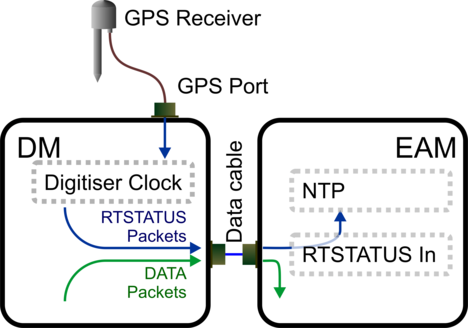
Note: RTSTATUS packets are available with MkIII DM24 units. Earlier units, such as MkIIs, are not capable of generating these packets.
Note: RTSTATUS packets are available with CD24 units running firmware revision 279 and above.
8.2 Using NTP with CMG-DAS units
Where GPS reception is not practical but an internet connection is available, NTP can be used to synchronise the Platinum clock, which can then generate NMEA output. This NMEA data-stream can be fed to the GPS input of the digitiser module using an external cable from a serial port.
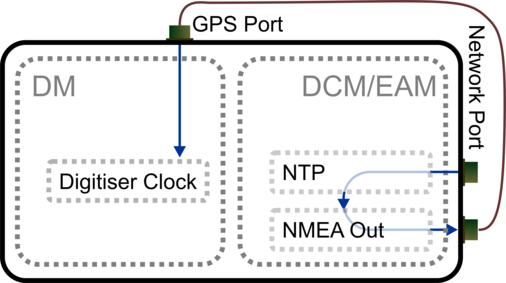
To configure the NTP subsystem, see section 6.3.
To configure NMEA output, see section 8.6.
8.3 Using GPS with Authenticated Digitisers
Güralp Systems Ltd's authenticated digitisers provide a CMG-DM24 and a CMG-EAM in a single package. An internal, bi-directional connection is made between Port C of the EAM and the digitiser module. This connection can operate in one of two modes:
An external GPS receiver can provide input to both the digitiser module's clock circuitry and the EAM's NTP subsystem; or
The EAM's NTP subsystem can provide NMEA to the digitiser module's clock circuitry. In this case, the external GPS socket is automatically disconnected.
The data flow when a GPS receiver is used is illustrated below:
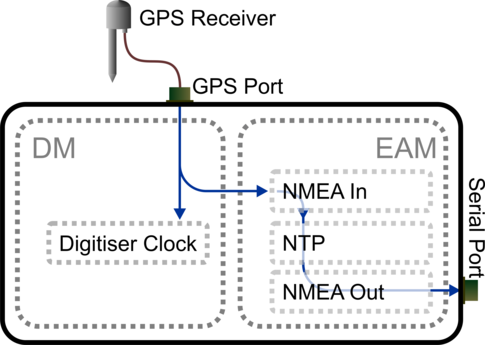
If required, the NTP subsystem can provide NMEA output via a serial port which can then be used to synchronise an additional digitiser. This, however, is optional and no serial port is dedicated to this use.
To configure the NTP subsystem, see section 6.3.
To configure NMEA as an NTP clock source, see section 8.5.
To configure NMEA output, see section 8.6.
8.4 Using NTP with Authenticated Digitisers
Please see the discussion of synchronisation options available with Authenticated Digitisers in the previous section.
The data flow when NTP is used as the primary clock source is illustrated below:
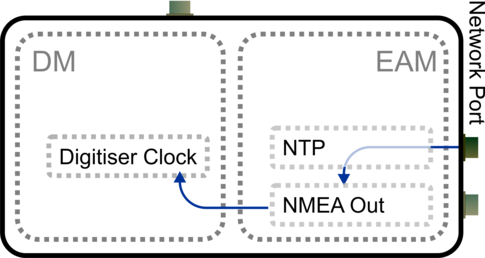
Note: The external GPS connector is disconnected when Port C of the EAM is set to “NMEA Out” and connected to the digitiser's GPS input in all other cases.
To configure NMEA output, see section 8.6.
8.5 Configuring NMEA as an NTP clock source
To configure NTP to use NMEA as a clock source, two steps are required. First, tick the Acquire time from connected GPS check-box in the NTP configuration page as described in section 6.3 on page 64.
Secondly, configure the relevant serial port as an NMEA input.
To do this, using the web interface, select “Serial ports” from the “Configuration” → “All options” menu or select the “Serial ports” short-cut from the “Configuration” → “Data transfer/recording options” menu. To configure an NMEA input from the command line, start gconfig and select “Serial ports” from the top level menu.
Next, select the serial port from which you want to input NMEA.
Note: For authenticated digitisers, this will be Port C. For more details of Authenticated Digitisers, please see section 14.2.
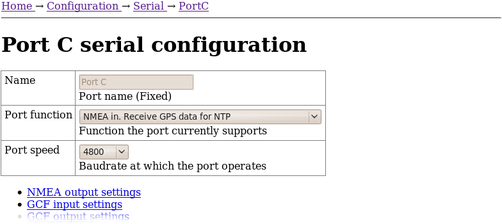
8.6 Configuring NMEA output
Platinum can generate simulated GPS data (NMEA-0183) to synchronise a connected digitiser's clock. In this case, the internal clock of the CMG-EAM is used as a reference for the digitiser. In order to provide a sufficiently accurate time-stamp, the clock must be controlled using NTP (See section 6.3).
To configure NMEA Output using the web interface, select “Serial ports” from the “Configuration” → “All options” menu or select the “Serial ports” short-cut from the “Configuration” → “Data transfer/recording options” menu. To configure NMEA Output from the command line, start gconfig, select “Serial ports” from the top level menu.
Next, select the serial port from which you want to output NMEA. Only one port can be used for NMEA output at any time: the timing constraints are such that a single processor cannot produce the pulse-per-second (PPS) signal on two ports simultaneously with sufficient accuracy.
Note: For Authenticated Digitisers, Port C should be used in order to provide NMEA output to the internal digitiser module. If a GPS receiver is used, the “Data Out” Port (exposed as the DATA connector) can be used to provide timing to additional, external digitisers.
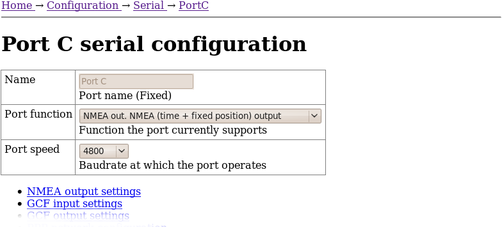
Go back the configuration of the serial port and click on “NMEA output settings”. You will see this screen:
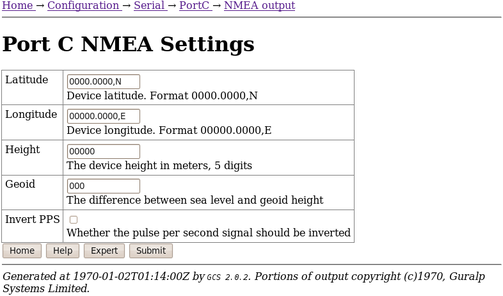
Here, you can configure the NMEA sentences that will be sent to the digitiser. You can specify the location (latitude, longitude, elevation), the geoid (the offset of the location from the theoretical earth surface) and whether to invert the Pulse-Per-Second signal (if unchecked, the PPS line will be briefly asserted each second, on the second, and held to ground at other times). It is not essential that the position string sent matches the physical location of the digitiser, as only the GPS time signal is used by the digitiser. Click “Submit” to save the changes.
The following additional parameters are available in expert mode:
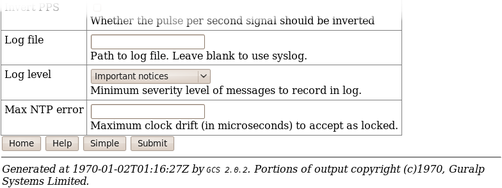
It may sometimes be desirable, for debugging purposes, to separate log messages for this input from the standard system log. The Log file text field can be populated with a path name which will then be used for dedicated logging. If left blank, logging occurs (via the standard Linux syslog facility) to /var/log/messages.
The Log level drop-down menu controls the level of detail present in log messages, whether to syslog or to a dedicated log file. Not all of the standard syslog logging levels are available. The menu offers a choice (in order of decreasing detail) of:
Debugging information;
Informational messages;
Important notices; or
Warnings
The Max NTP error text field controls the accuracy of synchronisation which must be achieved by NTP before the resulting NMEA sentences will will indicate that the “GPS” is locked.